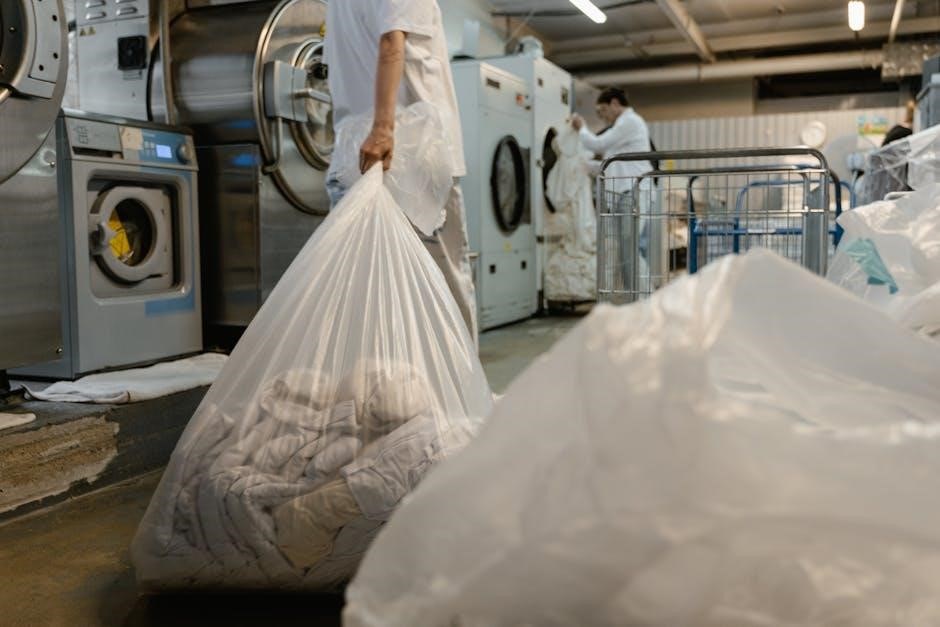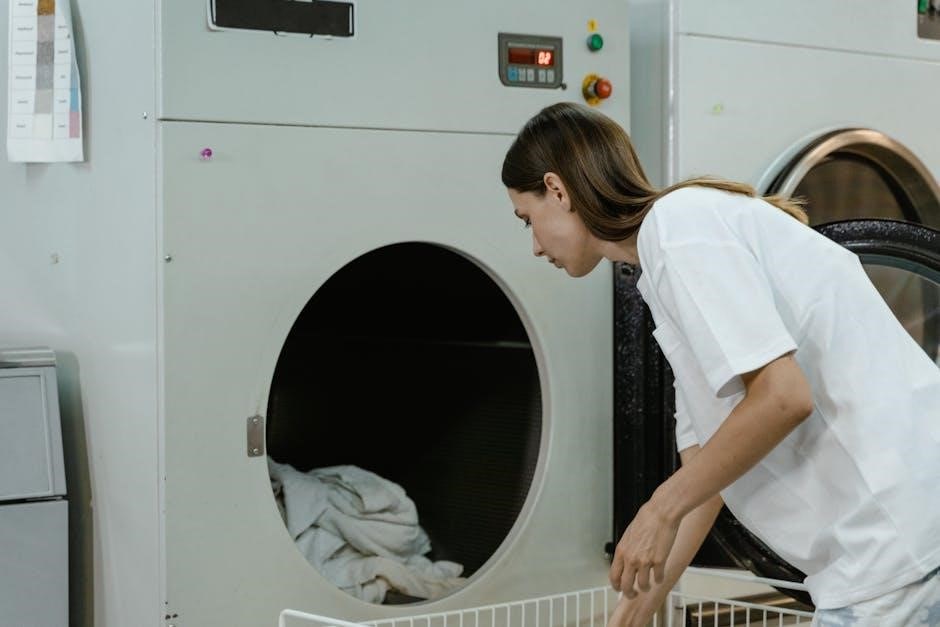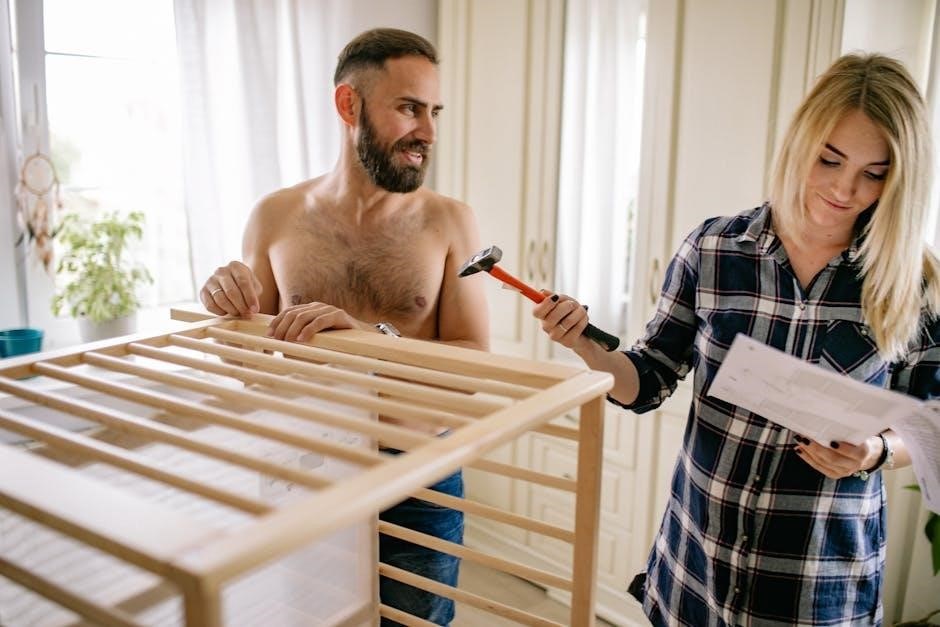Welcome to the Amana dryer instruction manual. This guide provides essential information for safe and efficient operation of your Amana dryer. It covers setup, operation, maintenance, and troubleshooting to ensure optimal performance and longevity of your appliance. Always follow safety guidelines for best results.

Safety Guidelines
Always read and follow the safety guidelines in this manual. Proper installation, venting, and maintenance are crucial. Ensure the vent is not crushed or kinked, and avoid blockages. Follow all safety precautions to prevent accidents and ensure efficient dryer operation.
2.1 General Safety Precautions
Adhering to general safety precautions is essential for the safe and efficient operation of your Amana dryer. Always read this manual thoroughly before using the appliance to understand its proper operation and maintenance. Ensure the dryer is installed correctly by a qualified technician to avoid potential hazards. Proper venting is crucial to prevent issues such as long drying times or increased energy consumption. Never allow the vent to be crushed or kinked, as this can lead to poor performance or safety risks.
Avoid placing flammable materials near the dryer, and keep the area around it clear of clutter. Children should be supervised when the dryer is in use, and they should not play with the appliance or its controls. Always use the correct electrical outlet and ensure the dryer is properly grounded to prevent electrical hazards. Do not overload the dryer, as this can cause damage or inefficient drying. Regularly clean the lint filter to maintain airflow and reduce the risk of fires. Never leave the dryer unattended during operation, and always follow the recommended drying times and settings for different fabric types. By following these general safety precautions, you can ensure a safe and efficient drying experience. For more detailed safety information, refer to the specific guidelines provided in this manual.
2.2 Model-Specific Safety Information
Model-specific safety information is crucial for the safe operation of your Amana dryer. For models like the Amana NED4655EW and NGD4655EW2, ensure proper installation by a qualified technician to avoid potential hazards. These models require specific venting configurations to maintain efficiency and safety. Always check the vent for kinks or blockages, as this can increase drying times and pose safety risks. Additionally, fabric softener sheets should not block the grille, as this can reduce airflow and performance.
For stackable models, ensure the washer and dryer are properly aligned and secured to prevent tipping. Always follow the manufacturer’s guidelines for stacking to ensure stability. Regularly inspect the power cord and electrical connections to prevent damage or electrical hazards. Never overload the dryer, as this can cause damage or inefficient drying. Specific to some models, the user manual may include additional safety features or warnings tailored to the appliance’s design. Always refer to your model’s manual for detailed safety guidelines. By adhering to these model-specific safety precautions, you can ensure optimal performance and safety for your Amana dryer.

Installation Instructions
Proper installation is essential for safe and efficient operation of your Amana dryer. Place the dryer on a level surface and ensure all electrical connections are secure. Follow the manufacturer’s guidelines for venting to prevent obstructions and maintain proper airflow. Ensure the venting system is not crushed or kinked, as this can increase drying times and pose safety risks. Always refer to the specific model’s manual for detailed installation instructions, and consider hiring a qualified technician for professional setup. Proper installation ensures optimal performance, safety, and longevity of your Amana dryer.
3.1 Initial Setup and Requirements
Before using your Amana dryer, ensure proper initial setup to guarantee safe and efficient operation. Begin by carefully unpacking the dryer and inspecting it for any damage or missing parts. Place the dryer on a level, stable surface in a well-ventilated area, as uneven surfaces may lead to vibration or imbalance during operation.
Check the power supply requirements, ensuring the dryer is connected to a grounded electrical outlet rated for the specified voltage and amperage. Refer to your model’s manual for exact electrical requirements. If the dryer is gas-powered, ensure the gas line is properly connected and leak-tested by a qualified technician;
Inspect the venting system to ensure it is clear of obstructions, kinks, or crushes. Proper venting is crucial for efficient drying and safety. Use the provided venting kit or equivalent, and ensure all connections are secure. If venting through a wall or roof, verify that the termination point is clear of debris and functioning correctly.
Finally, before first use, run the dryer empty on a low heat setting to ensure all systems are functioning properly. This step helps identify any potential issues with installation or setup. Always follow the manufacturer’s guidelines for specific model requirements, as detailed in your Amana dryer manual.
3.2 Venting Requirements and Recommendations
Proper venting is essential for the safe and efficient operation of your Amana dryer. Ensure the venting system is installed according to the manufacturer’s specifications to avoid potential hazards and optimize performance. Use only rigid metal ducts or flexible metal venting, as plastic or foil ducts can pose fire risks and are not recommended.
The venting system should be as short as possible, with a maximum length specified in your model’s manual. Avoid sharp bends or kinks, as these can restrict airflow and increase drying times. Secure all connections tightly to prevent leaks. If venting through a wall or roof, ensure the termination point is clear of debris and protected from the elements.
Regularly inspect and clean the venting system to remove lint buildup, which can cause efficiency issues or safety hazards. Use a dryer vent cleaning brush or consult a professional if necessary. For gas-powered models, ensure the venting system is designed to handle exhaust gases safely. Always follow local building codes and regulations when installing or modifying the venting system.
Refer to your Amana dryer manual for specific venting requirements tailored to your model. Proper venting ensures efficient drying, reduces energy consumption, and helps maintain the longevity of your appliance. If unsure about any aspect of venting, consult a qualified installer or technician for assistance.

Using the Amana Dryer
Using your Amana dryer is straightforward once you understand the basic operations. Start by selecting the appropriate cycle for your load type. Choose from options like Normal, Delicate, or Heavy Duty. Adjust settings such as temperature and time based on fabric care instructions. Ensure the dryer is properly loaded, avoiding overloading, and add a dryer sheet if desired. Close the door securely and press Start. Always refer to your model-specific manual for detailed cycle descriptions and custom settings to achieve optimal results.
4.1 Understanding Cycle Selection
Selecting the right cycle on your Amana dryer ensures your clothes are dried properly. The Normal cycle is ideal for everyday loads like cottons and linens, offering a balanced combination of time and heat. For delicate fabrics such as lingerie or wool, choose the Delicate cycle, which uses lower heat and gentler tumbling to prevent damage; Heavy Duty cycles are designed for bulky items like towels and jeans, providing longer drying times and higher heat for thorough drying. Some models also feature specialized cycles like Quick Dry for small loads that need fast results and Steam Refresh to reduce wrinkles and odors. Always match the cycle to the fabric type to maintain garment quality and extend the life of your clothes; Refer to your user manual for specific cycle options available on your model. Proper cycle selection enhances drying efficiency and protects your fabrics from damage, ensuring optimal performance from your Amana dryer.
4.2 Customizing Drying Settings
Customizing drying settings on your Amana dryer allows you to tailor the drying process to your specific needs. Most models feature a control panel with options to adjust temperature, drying time, and additional settings. Temperature settings range from low to high, with lower heat suitable for delicate fabrics and higher heat for bulky items like towels. Some models also include moisture-sensing technology, which automatically adjusts drying time based on the dampness of the clothes, ensuring they are dried thoroughly without over-drying.
In addition to temperature and moisture settings, many Amana dryers offer specialized options such as Steam Refresh, which uses steam to reduce wrinkles and odors, and Sanitize, which uses high heat to kill bacteria and germs. You can also select extended tumble to keep clothes tumbling after the cycle ends, preventing wrinkles from setting in. For energy efficiency, some models include an Eco mode that reduces heat and extends drying time. Always refer to your user manual for specific customization options available on your model. By adjusting these settings, you can optimize the drying process for different types of fabrics and achieve better results while extending the life of your clothes.

Maintenance and Care
Regular maintenance ensures your Amana dryer operates efficiently and safely. Clean the venting system to prevent blockages and improve airflow. Check for lint buildup and remove it after each use. Refer to the manual for detailed care instructions to maintain performance and longevity.
5.1 Cleaning the Dryer
Regular cleaning is crucial for maintaining your Amana dryer’s performance and safety. Start by unplugging the dryer to avoid any accidents. Remove lint from the lint filter after each use to ensure proper airflow. Use a soft brush or vacuum cleaner to clean the venting system, as clogged vents can increase drying times and energy consumption. Check the moisture sensor for residue and wipe it clean with a soft cloth. For the exterior, use a mild detergent and damp cloth to remove dirt and stains. Avoid harsh chemicals that might damage the finish. Inside the drum, wipe down any stubborn stains with a damp cloth, but ensure it is dry before the next use. Cleaning the dryer regularly prevents lint buildup, reduces fire risks, and keeps your appliance running efficiently.
5.2 Replacing Parts
Replacing parts in your Amana dryer is essential for maintaining its performance and extending its lifespan. Always use genuine Amana replacement parts to ensure compatibility and reliability. Before starting any replacement, unplug the dryer from the power source to avoid accidents. For most parts, such as the lint filter, belts, or drum rollers, you can purchase them directly from Amana or authorized retailers. Refer to your model-specific manual (e.g., Amana NED4655EW or NGD4655EW2) for exact part numbers and diagrams.
When replacing parts, follow these steps:
Turn off and unplug the dryer.
Disconnect the venting system if accessing internal components.
Use a screwdriver to remove panels or access the part.
Carefully remove the old part and install the new one.
Reassemble the dryer and ensure all connections are secure.
Common parts to replace include the lint filter, drum rollers, and belts. If you’re unsure about a replacement, consult a professional technician to avoid damaging the appliance or voiding the warranty. Regular part replacements can improve efficiency and prevent breakdowns.

Venting and Ducting
Proper venting and ducting are crucial for the safe and efficient operation of your Amana dryer. A well-installed venting system ensures that moisture, lint, and heat are safely expelled outdoors, reducing drying times and improving energy efficiency. Always use a rigid metal duct or flexible metal ducting, as plastic or foil ducts can sag, restrict airflow, or pose fire hazards.
Key considerations for venting include:
Ensure the venting system is not crushed or kinked, as this can block airflow and increase drying times.
The vent should be as short as possible, with a maximum length of 35 feet for electric dryers (or 40 feet for gas dryers) to maintain performance.
Install a vent hood or exterior vent cap to prevent debris and pests from entering the duct.
Regularly inspect and clean the venting system to remove lint buildup, which can cause fires or reduce efficiency.
For optimal performance, avoid using flexible plastic ducts, as they can collapse or trap lint. Instead, use UL-listed ducting materials that meet safety standards. Always follow local building codes and manufacturer recommendations when installing or modifying your venting system. Proper venting not only enhances dryer performance but also helps maintain safety and energy savings.

User Manuals
Your Amana dryer user manual provides detailed guidance on operation, maintenance, and troubleshooting. It includes warranty information, safety precautions, and product features. Manuals are available online as PDF downloads, specific to your model, ensuring easy access to comprehensive instructions for optimal appliance use.
7.1 Accessing Specific Model Manuals
To access the user manual for your specific Amana dryer model, visit the official Amana website or authorized appliance repair websites. Enter your dryer’s model number, such as NED4655EW or NGD4655EW2, to find the corresponding manual. These manuals are available in PDF format for easy downloading and printing. Ensure you have the correct model number, as instructions vary by product. The manual will include detailed information on installation, operation, and maintenance specific to your dryer. Additionally, it will cover troubleshooting tips, warranty details, and safety guidelines tailored to your model. For further assistance, Amana provides customer support and online resources to help you navigate any issues. Always refer to the official sources for accurate and reliable information. This ensures you have the most up-to-date guidance for your appliance. By following the manual’s instructions, you can optimize your dryer’s performance and extend its lifespan. If you cannot find your model online, contact Amana directly for assistance. Manuals are also available through retailers or repair services if needed. Make sure to review the manual thoroughly to understand all features and maintenance requirements. This will help you use your dryer safely and efficiently.
Troubleshooting Common Issues
Facing issues with your Amana dryer? This section helps you identify and resolve common problems. Start by checking the power supply and ensuring the dryer is properly plugged in. If the dryer won’t start, verify that the door is closed securely and the start button has been pressed.
- Long Drying Times: Check for blocked vents or kinked hoses, as this restricts airflow. Ensure the lint filter is clean and replace it if necessary.
- No Heat: Verify that the dryer is set to a heat cycle. If the issue persists, check the circuit breaker or fuses, as the heating element may require a dedicated circuit.
- Strange Noises: Objects like coins or zippers may be causing noise. Stop the dryer, check for obstructions, and remove any loose items. If the noise continues, contact a technician.
- Error Codes: Refer to your model-specific manual for code meanings. Reset the dryer by unplugging it for 30 minutes and plugging it back in.
For persistent issues, consult the troubleshooting section in your model’s manual or contact Amana customer support. Regular maintenance, like cleaning vents and checking belts, can prevent many problems. Always follow safety guidelines when performing repairs.